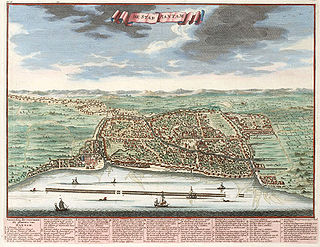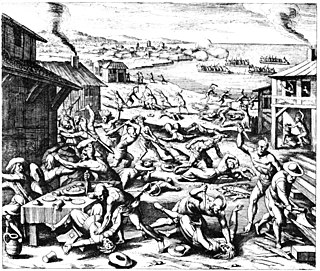
1648 (MDCXLVIII) was a leap year starting on Wednesday of the Gregorian calendar and a leap year starting on Saturday of the Julian calendar, the 1648th year of the Common Era (CE) and Anno Domini (AD) designations, the 648th year of the 2nd millennium, the 48th year of the 17th century, and the 9th year of the 1640s decade. As of the start of 1648, the Gregorian calendar was 10 days ahead of the Julian calendar, which remained in localized use until 1923.

1603 (MDCIII) was a common year starting on Wednesday of the Gregorian calendar and a common year starting on Saturday of the Julian calendar, the 1603rd year of the Common Era (CE) and Anno Domini (AD) designations, the 603rd year of the 2nd millennium, the 3rd year of the 17th century, and the 4th year of the 1600s decade. As of the start of 1603, the Gregorian calendar was 10 days ahead of the Julian calendar, which remained in localized use until 1923.

1640 (MDCXL) was a leap year starting on Sunday of the Gregorian calendar and a leap year starting on Wednesday of the Julian calendar, the 1640th year of the Common Era (CE) and Anno Domini (AD) designations, the 640th year of the 2nd millennium, the 40th year of the 17th century, and the 1st year of the 1640s decade. As of the start of 1640, the Gregorian calendar was 10 days ahead of the Julian calendar, which remained in localized use until 1923.

The 1620s decade ran from January 1, 1620, to December 31, 1629.

1618 (MDCXVIII) was a common year starting on Monday of the Gregorian calendar and a common year starting on Thursday of the Julian calendar, the 1618th year of the Common Era (CE) and Anno Domini (AD) designations, the 618th year of the 2nd millennium, the 18th year of the 17th century, and the 9th year of the 1610s decade. As of the start of 1618, the Gregorian calendar was 10 days ahead of the Julian calendar, which remained in localized use until 1923.

1652 (MDCLII) was a leap year starting on Monday of the Gregorian calendar and a leap year starting on Thursday of the Julian calendar, the 1652nd year of the Common Era (CE) and Anno Domini (AD) designations, the 652nd year of the 2nd millennium, the 52nd year of the 17th century, and the 3rd year of the 1650s decade. As of the start of 1652, the Gregorian calendar was 10 days ahead of the Julian calendar, which remained in localized use until 1923.
The 1630s was a decade that began on January 1, 1630, and ended on December 31, 1640.

1650 (MDCL) was a common year starting on Saturday of the Gregorian calendar and a common year starting on Tuesday of the Julian calendar, the 1650th year of the Common Era (CE) and Anno Domini (AD) designations, the 650th year of the 2nd millennium, the 50th year of the 17th century, and the 1st year of the 1650s decade. As of the start of 1650, the Gregorian calendar was 10 days ahead of the Julian calendar, which remained in localized use until 1923.
The 1600s was a decade of the Gregorian calendar that began on 1 January 1600, and ended on 31 December 1609.

1593 (MDXCIII) was a common year starting on Friday of the Gregorian calendar and a common year starting on Monday of the Julian calendar, the 1593rd year of the Common Era (CE) and Anno Domini (AD) designations, the 593rd year of the 2nd millennium, the 93rd year of the 16th century, and the 4th year of the 1590s decade. As of the start of 1593, the Gregorian calendar was 10 days ahead of the Julian calendar, which remained in localized use until 1923.

1602 (MDCII) was a common year starting on Tuesday of the Gregorian calendar and a common year starting on Friday of the Julian calendar, the 1602nd year of the Common Era (CE) and Anno Domini (AD) designations, the 602nd year of the 2nd millennium, the 2nd year of the 17th century, and the 3rd year of the 1600s decade. As of the start of 1602, the Gregorian calendar was 10 days ahead of the Julian calendar, which remained in localized use until 1923.

1621 (MDCXXI) was a common year starting on Friday of the Gregorian calendar and a common year starting on Monday of the Julian calendar, the 1621st year of the Common Era (CE) and Anno Domini (AD) designations, the 621st year of the 2nd millennium, the 21st year of the 17th century, and the 2nd year of the 1620s decade. As of the start of 1621, the Gregorian calendar was 10 days ahead of the Julian calendar, which remained in localized use until 1923.

1627 (MDCXXVII) was a common year starting on Friday of the Gregorian calendar and a common year starting on Monday of the Julian calendar, the 1627th year of the Common Era (CE) and Anno Domini (AD) designations, the 627th year of the 2nd millennium, the 27th year of the 17th century, and the 8th year of the 1620s decade. As of the start of 1627, the Gregorian calendar was 10 days ahead of the Julian calendar, which remained in localized use until 1923.

1643 (MDCXLIII) was a common year starting on Thursday of the Gregorian calendar and a common year starting on Sunday of the Julian calendar, the 1643rd year of the Common Era (CE) and Anno Domini (AD) designations, the 643rd year of the 2nd millennium, the 43rd year of the 17th century, and the 4th year of the 1640s decade. As of the start of 1643, the Gregorian calendar was 10 days ahead of the Julian calendar, which remained in localized use until 1923.

1592 (MDXCII) was a leap year starting on Wednesday of the Gregorian calendar and a leap year starting on Saturday of the Julian calendar, the 1592nd year of the Common Era (CE) and Anno Domini (AD) designations, the 592nd year of the 2nd millennium, the 92nd year of the 16th century, and the 3rd year of the 1590s decade. As of the start of 1592, the Gregorian calendar was 10 days ahead of the Julian calendar, which remained in localized use until 1923.

The 1580s decade ran from January 1, 1580, to December 31, 1589.

1591 (MDXCI) was a common year starting on Tuesday of the Gregorian calendar and a common year starting on Friday of the Julian calendar, the 1591st year of the Common Era (CE) and Anno Domini (AD) designations, the 591st year of the 2nd millennium, the 91st year of the 16th century, and the 2nd year of the 1590s decade. As of the start of 1591, the Gregorian calendar was 10 days ahead of the Julian calendar, which remained in localized use until 1923.

1580 (MDLXXX) was a leap year starting on Friday of the Julian calendar, the 1580th year of the Common Era (CE) and Anno Domini (AD) designations, the 580th year of the 2nd millennium, the 80th year of the 16th century, and the 1st year of the 1580s decade. As of the start of 1580, the Gregorian calendar was 10 days ahead of the Julian calendar, which was the dominant calendar of the time.

1578 (MDLXXVIII) was a common year starting on Wednesday in the Julian calendar.

1709 (MDCCIX) was a common year starting on Tuesday of the Gregorian calendar and a common year starting on Saturday of the Julian calendar, the 1709th year of the Common Era (CE) and Anno Domini (AD) designations, the 709th year of the 2nd millennium, the 9th year of the 18th century, and the 10th and last year of the 1700s decade. As of the start of 1709, the Gregorian calendar was 11 days ahead of the Julian calendar, which remained in localized use until 1923.

























